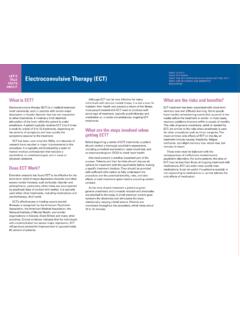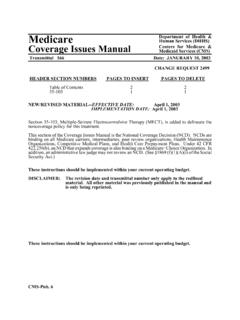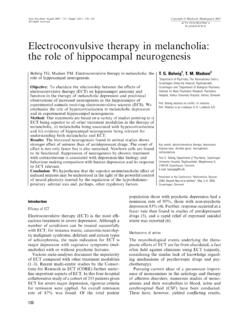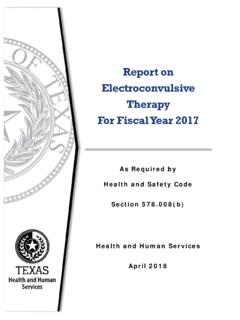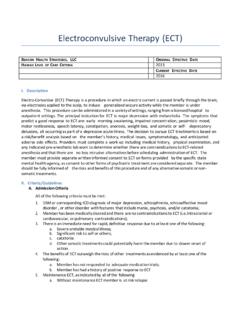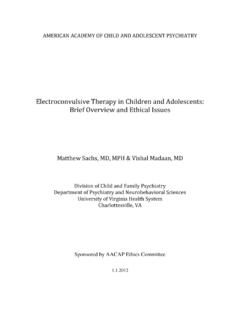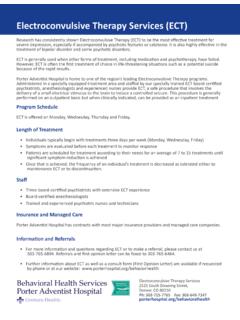Transcription of ELECTROCONVULSIVE THERAPY: A SECOND OPINION
1 ELECTROCONVULSIVE therapy : A SECOND OPINION APRIL 16, 2010 By Gary Null If you thought shock treatment was a thing of the past, you re wrong. ECT is making a comeback, with its supporters saying it helps depression and prevents suicide. There are three things you should know, though: It doesn t help depression. It doesn t prevent suicide. And patients coming out of this treatment can have more problems than they did going in including death. A grand mal seizure, when muscles contract violently and uncontrollably, is something doctors ordinarily try to prevent. Yet, with shock therapy s dramatic comeback, doctors are intentionally producing this type of seizure as a medical treatment. Shock therapy s advocates, who refer to the procedure as ELECTROCONVULSIVE therapy (ECT) to soften negative associations, proclaim that ECT is safe, painless, and effective.
2 It s the best treatment for deep depression, they say, and it saves lives by preventing suicide. Moreover, they claim, side effects, such as memory loss, are only temporary. The trend appears to be growing, with ECT now being used for a number of psychiatric ailments, including schizophrenia and obsessive-compulsive disorder, and even for some non-psychiatric conditions, such as Parkinson s But paralleling the growth of ECT is the growing number of critics of the treatment, both within and outside of the psychiatric establishment. Shock is not just ineffective, the opposition claims, it often leaves recipients in a worsened condition than before treatment. Depression and suicidal ideation soon return, complicated by ECT-induced brain damage and memory loss.
3 Plus new conditions, such as epilepsy and heart arrhythmias, can develop. Moreover, signing the permission form for this treatment may be signing your life away, as the risk of death during or soon after the procedure is great, far higher than ECT proponents admit, in part due to the targeting of fragile elderly populations. ECT s most ardent challengers, often former patients themselves, wonder how healing professionals could have forgotten their Hippocratic Oath to do no harm. They assert that ECT is a barbaric procedure that must be banned. In considering these diametrically opposed views, the tendency of the average person is to side with established medical authority and disbelieve the critics. After all, this is a supposedly therapeutic approach that s been widely used around the world for three-quarters a century.
4 Well-credentialed doctors are telling us that ECT is the single best therapy for alleviating depression and preventing suicide, and this is at a time when more than 30,000 Americans are taking their lives annually. Reasonableness would have us assume that the issue has been properly researched; the public views doctors as trustworthy, intelligent, and highly knowledgeable, if not god-like. On the other hand, critics of ETC are often those who have themselves been exposed to it, people labeled mentally ill. In our culture a mental patient is considered an irrational person, one not to be trusted. So when patients rights groups assert that people are being harmed, and in many cases forcibly shocked against their will, the tendency is to disbelieve, to think this can t be happening.
5 It s easy then to be swayed by distinguished doctors from prestigious universities and to dismiss the words of psychiatric patients as paranoid and delusional. One has to look beyond cultural assumptions to get to the reality of the situation. The fact is that over the years ECT has been the subject of numerous well-researched studies, many by ECT proponents themselves. They reveal, in brief, the following: ECT does not eliminate depression. Studies acknowledge a significantly high relapse rate just four weeks following 3 4 5 ECT is not a deterrent against 7 ECT damages the brain, and can cause permanent memory loss, seizures, and 9 10 11 Death rates from ECT may be as high as 1 in The Food and Drug Administration (FDA) classifies ECT machines as Class III devices.
6 This means they are high risk, unsafe, and pose an unreasonable risk of injury or illness. Furthermore, the benefits of Class III devices have not been shown to outweigh the risks they ECT experts in support of the modality have lucrative financial ties to the shock machine industry. One would expect these findings to place this controversial procedure under scrutiny, when, in fact, the opposite is occurring, with 100,000 Americans receiving treatment annually and with the numbers growing. Barbarous Beginnings When I saw the [first] patient s reaction, I thought to myself: This should be abolished! Ugo Cerletti, the originator of shock therapy Although we tend to celebrate medical advances, the history of medicine is also replete with failure and fraud.
7 Treatments for mental illness have been particularly susceptible to quackery, starting with the notion that evil spirits are to blame for the condition, and that inducing fever or vomiting could drive them out. Another early notion was the idea that insanity and epilepsy could not occupy the same brain at the same time. The practical application of this notion was seen in the treatment of some mental illnesses with huge doses of insulin and other drugs to create seizures. Seemingly remarkable albeit short-term improvements were sometimes noted with this Thinking along these lines, an Italian professor of psychiatry, Ugo Cerletti, concluded that using electricity to induce seizures in psychotic inmates could drive out insanity.
8 It s not a fact publicized by today s ECT advocates, but Cerletti, pioneered the procedure after witnessing slaughterhouse operators shock pigs into epileptic fits in order to facilitate the slitting of their throats. His initial experiment in the human realm was with a 39-year-old engineer found wandering in the streets. Because the man was speaking gibberish, he was sent to Cerletti for observation. Cerletti diagnosed him with Schizophrenic Syndrome. Treatment consisted of electrifying the man s temples with a pair of tongs used to stun hogs, after which the fellow burst into song. 15 As no seizure was induced, Cerletti and his colleagues discussed raising the voltage, an idea to which their subject, who had apparently returned to his senses, now responded, in perfect Italian, Not another one!
9 It s deadly. Despite his own reservations, Cerletti administered a SECOND , stronger current and caused a 17 From these questionable beginnings, ECT was born. In 1938, Italian psychiatrist Lucino Bini helped Cerletti build the first shock machine. Its use induced strong convulsions and caused irreversible brain damage. This led to the use of electric shock to destroy the personality. In 1942, Bini devised a procedure that he named annihilation therapy . This was nothing less than the repetitive use of ECT, many times a day, to induce a state of severe amnesia, something Bini believed would be useful for treating patients with obsessions, depression, and some types of paranoia. The effect of annihilation therapy has been compared to the state induced following a prefrontal One of electroshock s most zealous advocates was German psychiatrist Lothar B.
10 Kalinowsky, who initiated the technique s use throughout Europe and vigorously promoted it in the Initially, the American psychiatry rejected the idea that brain damage could foster healing, but it soon changed its mind and embraced the technique. In 1942, one impassioned advocate, Dr. Abraham Myerson, commented: The reduction of intelligence is an important factor in the curative fact is that some of the very best cures that one gets are in those individuals whom one reduced almost to amentia [mindlessness]. 19 Notes Moira Dolan, an Austin, Texas, doctor who advocates a ban on the procedure, When we look back at the beginnings of electric shock there was truth in advertising [with such labels as] as annihilation therapy and amentia.
